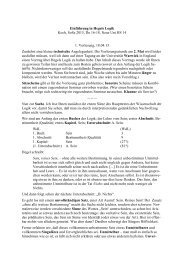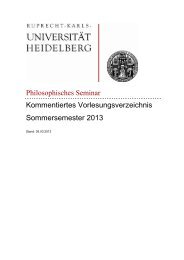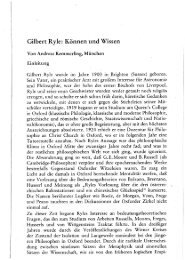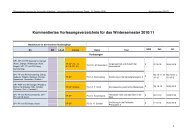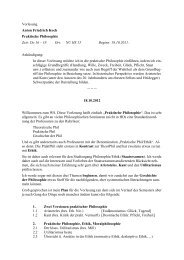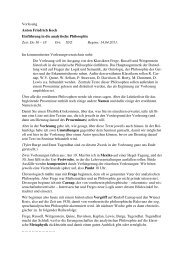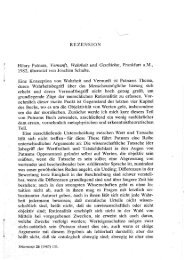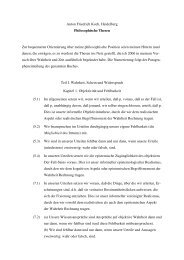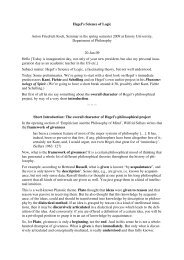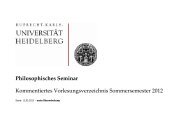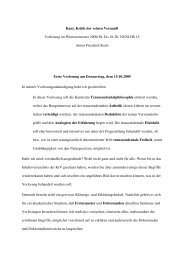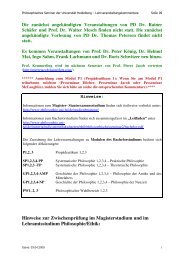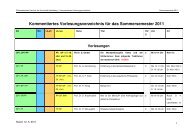KANT'S CRITIQUE OF TELEOLOGY IN BIOLOGICAL EXPLANATION
KANT'S CRITIQUE OF TELEOLOGY IN BIOLOGICAL EXPLANATION
KANT'S CRITIQUE OF TELEOLOGY IN BIOLOGICAL EXPLANATION
You also want an ePaper? Increase the reach of your titles
YUMPU automatically turns print PDFs into web optimized ePapers that Google loves.
68 Kant's Logic<br />
outside the sphere of an other." 1 8 Kant generally uses a Latin<br />
example to illustrate the distinction between negative and infinite<br />
judgments, since it is possible in Latin to distinguish between a<br />
negated copula and a negated predicate by the word order of the sentence<br />
(non est, est non).<br />
Since the argument that Kant is trying to make with the figure<br />
of the antinomy seems to hinge on the distinction between a<br />
negative judgment (The world is not finite) and an infinite judgment<br />
(The world is non-finite), it will be worthwhile to study this difference<br />
more closely. 19 The distinction between the two is basically that<br />
in negative judgments, the statement itself is negated, or for<br />
singular judgments simply the copula, whereas in infinite judgements<br />
the negation applies merely to the predicate term. Kant<br />
apparently sees a difference between denying the ascription of a<br />
predicate and asserting the negation of a predicate.<br />
Kant was certainly not the first to distinguish infinite and<br />
negative judgments, although the distinction was not part of the<br />
dominant tradition. According to a survey by Tonelli 16 of the 49<br />
eighteenth century German logic books examined list the infinite<br />
judgment as a separate category. 20 But even those logicians who<br />
rejected or ignored infinite judgments (iudicia infinita) often had a<br />
place in their systems for negated or infinite terms (termini infiniti,<br />
18 Kant, Logic, §22 (Ak 9,103-4; W 3,534). This extensional characterization of<br />
the differences between the forms of judgment states that affirmative judgments<br />
place the things referred to by the subject term in the class of objects characterized<br />
by the predicate. The negative judgment denies their membership in this class.<br />
The infinite judgment asserts their membership in an incompatible class which<br />
is not necessarily coextensive with the complementary class.<br />
19 The distinction was apparently not universally observed in Kant's time, and<br />
some logicians seem to have equated or conflated contrary and contradictory<br />
oppositions (cf. Lambert, fn 24 below). In one of his lectures Kant remarks: "It is<br />
puzzling that logicians have called contrariety a contradiction." (Ak 24,470).<br />
20 There is no definitive analysis of the function of Kant's distinction of a third<br />
quality of judgment. In general, the infinite judgment is treated along the lines<br />
set by Schopenhauer as "a false window, of which there are many attached for the<br />
sake of symmetrical architectonics" (p. 541). Menne's otherwise very helpful<br />
study, "Das unendliche Urteil," also suffers from this 'Schopenhauer syndrome'<br />
of explaining a text by psychological speculation instead of philosophical analysis.<br />
Tonelli, "Voraussetzungen," examined close to 50 different eighteenth century<br />
logic texts and found that a third of them accorded some official status to<br />
infinite judgments. On the background of Klaus Reich's interpretation, L.<br />
Krüger in "Wollte Kant...?", makes a number of suggestions for interpreting<br />
this section of the CPR which will be taken up below.



